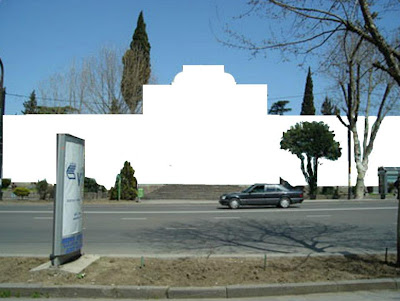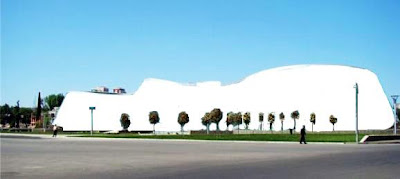'The mere aspiration of an artist has to be
improving the world and without the protest this can not be achieved'- tells me David
Kukhalishvili while I intrude into his home studio. 'I protest against us not being
a country'- and fair enough, the points Kukhalashvili raises in his art
paint quite a grim and accurate reality of the country.‘I try to create
art that will be readable to everyone, I don't want it to be exclusive for
artists and art historians, I want to reach everyone from the market sellers to
the elite.’
Perceiving Neo-Socialism
as the only adequate and promising future for the humanity, Kukhalashvili’s art
is in direct dialogue with the daily realities of Georgia. His photo series Not
Working, of the blanked out buildings- the institutions that do not
function for him is one of the vivid examples. The building of the Public
Broadcaster, the Ministry of Internal Affairs, the Patriarchy, the City Hall,
the President’s palace, the Supreme Court-all of them make up the list. Each of
these edifices refers to specific events and decisions that the artist
disapproves of; Kukhalashvili did not like the priests sabotaging
anti-homophobic demonstration. The Ministry of Internal Affairs got wiped out
when the students protesting the inhumane labor code got arrested. The National
Gallery is included because of neglecting the contemporary artists and rotating
around the same names. Some of the newly built buildings, acting as the
visiting cards for the President Saakashvili are also portrayed as white silhouettes-
discontent with their inadequacy towards the surroundings- most of these
buildings are squished into the old part of Tbilisi, ruining the historical
vista.
The aesthetics
of graphic design might be the only imprint of the Tbilisi State Academy of
Arts on Kukhalishvili's oeuvre (where he attended graphic design classes),
which is also included in his list of white buildings. Arguably the academy
would not approve of such bold thinking and expressing on canvas.
Working in
series as most of the Georgian artists of his period, the ideas spread on
couple of canvases do indeed convey the message more precisely. One of them is
about the almost terrifying rate of women who sneak out of the country in order
to work illegally in the West and support their families from there. In recent
years the theme became the focus of many Georgian artists opening up in the
documentary Women from Georgia by Koguashvili, who might even be the
first to see it as a social problem rather than a couple of coincidences. Kukhalashvili
has also created interesting canvases. The busses as the main transport for
departing are heading towards the map of Europe coloured in pink personifying
the hopes and expectations of these women whose planed stay of maximum 5 years
usually exceeds to forever as the families left never manage to save up or
start working. The same pink continent acts as a background for the cars, which
presumably symbolise the cars the families left in Georgia buy from the money
sent.
Evidently,
Kukhalashvili puts a lot of thought is in his colour choices, in harmony with
their symbolism. The series with black backgrounds that engulf the central
objects convey certain things about Georgia. One of the most striking from the
series is a pink bus stop stuck in the middle of nowhere. From the inside it is
adorned with different flags; this is Georgia stuck in constant mode of
optimistic waiting for the other countries to help. Trapped in the middle of
nowhere, all the dreams, ambitions, aspirations and generally the lifestyle
seems so inadequate and distanced to the much-desired Europe.
There is a
central rubbish bin with a halo taking the stage of noble subjects, of saints
and kings. The artist explains: ‘for many the rubbish bins are the only source of food. There is a
hierarchy among these people and every area has its own owner. For them these
rubbish bins are sacred.’
The other objects seemingly mundane and unworthy of canvas space are the
hospital beds, which turns out is a critique of the indifference most of the
doctors have towards the patients. If they are not paid in advance they easily
let the patients die, so if you are the lucky one affording to pay the
fees-signified by the red ropes around and the balloons are to hint- this has
to be celebrated. ‘If you get to the
hospital you are a VIP’ says the artist without a hint of sarcasm.
Kukhalashvili keeping a close eye on the news would not let the
political situation slide out of his all-criticising canvases. However, he has
found a very unusual form for this. He presents politics as the playground- especially relevant for the country as Georgia where
the same faces adjust to the seemingly irrelevant positions- Dimitri Shashkin
being the Minister of Justice, then Minister of Education and then Minister of
Defence or Irakli Okruashvili who started out as the Minister of Internal
Affairs, moving to being the Minister of Defence and then to the Minister of
Agriculture. In a country as such the politics resembles a game and the
politicians seem to be playing and having fun rather than working for a
country. This feeling is intensified with the regime of constant elections,
whose winner was known in advance for quite some time. Due to the corruption
and the inexistent alternatives, the National Movement party used to be the
ultimate winner. Kukhalashvili translated these conditions in the football
fields and tennis courts where it is impossible to score on one of the sides.
In general Kukhalashvili is not satisfied with the politicians of today and
says they do not feel the responsibility as to why they are getting paid by the
people. His protest against these individuals is expressed in the void facades
of the government offices, leaving the sensation of emptiness as it is not inhibited by humans that do not work for humans. 'I believe in a society forcing them to work
for people. I want to provoke protest in
the society with my art rather than awakening the sense of responsibility in
these officials.’
At present the artist works on the
project Geomemory revolving around the central square in the hometown of
Tbilisi. During the Communist regime, there was a statue of Lenin, the unstable
90s saw the square empty, an epicentre of the Civil War, it was renamed into
the Freedom Square. When Mikheil Saakashvili came to power he installed a
sculpture of the Saint George.
‘I decided to convey my message in style of
cube-futurism, which in itself was motivated by the Marxist thought, they
believed work would lead humans to happiness, there would be no wars; doomed
for failure it was a fairytale they believed in. All of it reminded of the
times we lived in, the way Akaki and Ilia believed that Iveria would shine,
ironically the school behind them was burnt on the way to enlightenment'.
The language of cube-futurism is the leitmotiv of these three canvases; the Communist Tbilisi, anarchic 90s and the Rose Revolution.
The formalism of the first and the last canvases is quite similar,
according to Kukhalashvili this signifies the similarities in governing- the
totalitarian regimes.











.jpg)



